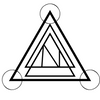The axolotl is an emblematic and iconic animal of the Mexican, but nowadays also of science, for its capacity for cellular regeneration, since it can regenerate parts of its body, a subject related to stem cells. But also for its reproductive capacity in the larval stage.
The spirit of this animal was recognized by ancient cultures that saw it as a being that defies death. In Aztec mythology, the axolotl (from Nahuatl: atl, "water" and xolotl, "monster"; aquatic monster), is the aquatic dedication of the god Xólotl, twin brother of Quetzalcóatl and monstrous because of the twin birth.
His story begins in the myth of creation of Sun and Moon, which occurred in Teotihuacán, "The place where men become gods", one of the most sacred places for the Nahuas, the great divine temple-city (today San Juan teotihuacán, near Otumba).

The fifth sun was created here, the era in which we currently live and which, according to the Nahua worldview, will disappear due to tremors.
So in the beginning of that era, when there was still nothing, no time, the day was in the most absolute
darkness, in the land of darkness. Then the gods met, owners of the movement, and in Teotihuacán they said: "Who will create the light, who will light the world?"
Tecuciztécatl , «The precious, adorned and pretentious god», a very rich divinity that everything he offered was precious, like the quetzal feathers, he went ahead and said: «I will take charge». Immediately the gods asked themselves: "Who will be the other one?"
There was absolute silence. No other god dared to volunteer. Everyone feared sacrificing. They did nothing more than look at each other. There were plenty of excuses for not being chosen. Then the gods remembered Nanahuatzin , "The bubbly, mangy god," a very withdrawn god who did not speak. Then they asked him to be the one to give birth . Nanahuatzin willingly and without hesitation accepted: "I will obey what they have commanded me," he said.
And then a huge bonfire was set up in the place called Teotexcalli , "The house of the rock of the gods ", a place considered as " The home of the divine ". For four days (or if you want better nights) they did penance in some mountains called Tzaqualli, which means something like" El place of confinement ».
While Nanahuatzin offered maguey thorns with his blood, green reeds tied three by three and balls of hay, Tecuciztécatl offered thorns made of precious stones, of red coral instead of blood, quetzal feathers and gold balls, delighting the nose with the best copal. Instead of copal, Nanahuatzin burned the scabs from his bubas.
At the end of the offering they began to adorn Nanahuatzin and Tecuciztécatl; one was adorned with precious feathers from Aztacómitl, the other was touched on the head with a paper Maxtli.
With everyone around, in the Teotexcalli the fire burned for four nights. The gods then stood in two rows beside the fire, ready to witness the spectacle. Nanahuatzin and Tecuciztécatl were placed in front of the fire, in the middle of the other gods. And then the latter ordered: «Come Tecuciztécatl! Enter the fire! »
Tecuciztécatl and Nanahuatzin in front of the fire
Although he rushed against the huge pyre, fear overcame him and he backed off. He tried again, up to four times, the limit allowed by the gods themselves. Then they turned to Nanahuatzin and said: "Come Nanahuatzin! Enter the fire!"
He closed his eyes, and immediately threw himself at the stake. It began to creak in the fire, and it was when Tecuciztécatl also threw himself. At that moment an eagle passed so close that they say that is why eagles have black feathers. A tiger also passed, and since it did not burn, it only burned a little, that is how it was half stained.

Nanahuatzin is thrown into the fire
Then the gods expected Nanahuatzin to come out. Suddenly everything turned reddish, as if everywhere was dawning. The gods knelt down to see Nanahuatzin appear as light star. It was not known where it would come from, because there was light everywhere. Then certain gods like Quetzalcoátl, "The feathered serpent", looked to the east and said: "This is where the sun will come out of."

Sacrifice of Nanahuatzin for the Tonalamatl Ollin
Nanahuatzin's brilliance was such that no one could look at him. After him and in the same place Tecuciztécatl appeared. And the gods wondered, "Is it okay for the two of them to go together?" "No!" They answered each other.
At this moment one of the gods hit Tecuciztécatl with a rabbit, thus suppressing the glare, leaving the moon as it is now.
After a while the sun and moon had appeared, the gods realized that they remained motionless, so they said: "How can we live with a sun without movement?"
"Let's sacrifice ourselves and make him rise with movement for our death." And then Echécatl, god of the wind, took it upon himself to kill the gods. However, history says that there was a god, Xólotl , a twin of Quetzalcoátl, who refused to die .
At that time Xolotl said: "O gods, may I not die!" This god was crying so much that his eyes bulged. When Ehécatl came to kill him , Xólotl escaped in terror.

He fled into the cornfields where he hid among the cornfields. There it became the corn stem that has two stalks, which the farmers call xólotl. When the wind discovered him, he ran and hid among the magueyes, becoming what is known as mexólotl, "two-body maguey"; when he was found again, he fled again.
Xolotl tries to go unnoticed as a maguey by the Tonalamatl Ollin
Xólotl captured as axolotl
Finally dipped into the water , becoming axólotl , the axolotl, where he was captured and killed to consecrate himself forever as one of the favorite delicacies of the Aztec princes.



